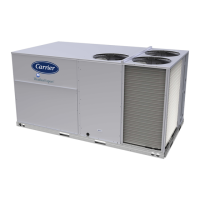5
Accessory Navigator Display
The accessory hand-held Navigator display can be used with
the 48/50LC units. (See Fig. 4.) The Navigator display is
plugged into the LEN (local equipment network) port on either
the SystemVu display or the Main Base Board (MBB).
Fig. 4 — Accessory Navigator Display
NAVIGATOR DISPLAY OPERATION
The Navigator display has up and down arrow keys, an ES-
CAPE key and an ENTER key. These keys are used to navigate
through the different levels of the display structure.
The four keys are used to navigate through the display struc-
ture, which is organized in a tiered mode structure. If the but-
tons have not been used for a period, the display will default to
the AUTO VIEW display category as shown under the RUN
STATUS category. To show the top-level display, press the ES-
CAPE key until a blank display is shown. Then use the up and
down arrow keys to scroll through the top-level categories.
These are listed in Appendix C and will be indicated on the
Navigator display by the LED next to each mode listed on the
face of the display.
When a specific mode or submode is located, push the ENTER
key to enter the mode. Depending on the mode, there may be
additional tiers. Continue to use the up and down keys and the
ENTER keys until the desired display item is found. At any
time, the user can move back a mode level by pressing the ES-
CAPE key. Once an item has been selected the display will
flash showing the item, followed by the item value and then
followed by the item units (if any).
Items in the Configuration and Service Test modes are pass-
word protected. The display will flash PASS and WORD when
required. Use the ENTER and arrow keys to enter the four dig-
its of the password. The default password is 1111.
Pressing the ESC and ENTER keys simultaneously will dis-
play an expanded text description across the display indicating
the full meaning of each display point. Pressing the ESCAPE
and ENTER keys when the display is blank (MODE LED lev-
el) will return the display to its default menu of rotating AUTO
VIEW display items. In addition, the password will need to be
entered again before changes can be made.
Changing item values or testing outputs is accomplished in the
same manner. Locate and display the desired item. If the dis-
play is in rotating auto-view, press the ENTER key to stop the
display at the desired item. Press the ENTER key again so that
the item value flashes. Use the arrow keys to change the value
of state of an item and press the ENTER key to accept it. Press
the ESCAPE key and the item, value or units display will re-
sume. Repeat the process as required for other items.
There are some points that can be forced from the Navigator
display. If the user needs to force a variable, follow the same
process as when editing a configuration parameter. A forced
variable, regardless where the force has come from will be dis-
played with a blinking “f” on a Navigator display following its
value. For example, if economizer commanded position
(EC.CP) is forced, the Navigator display shows “80f”, where
the “f” is blinking to signify a force on the point. Remove the
force by selecting the point that is forced with the key ENTER
and then pressing the up and down arrow keys simultaneously.
Depending on the type of unit (48LC or 50LC), factory-installed
options, and field-installed accessories, some of the items in the
various Mode categories may not apply. See Table 2 and Appen-
dix C for full Navigator display menu layout.
Run Sta
tus
Se
rvice Test
Temp
eratures
P
ressures
Setpoints
Inpu
ts
Outputs
C
onfigura
tion
Time C
lock
Oper
ating M
o
d
es
Alarms
ENT
ER
E
S C
M O
D E
Ala rm
St a
tus
TIM
E
EW
T
LW
T
SETP
1 2 .58
54. 6 °
F
4 4 .1° F
4 4 . 0 ° F
N A V IGA
T O R
C o m for t L ink

